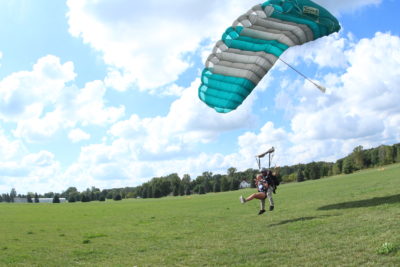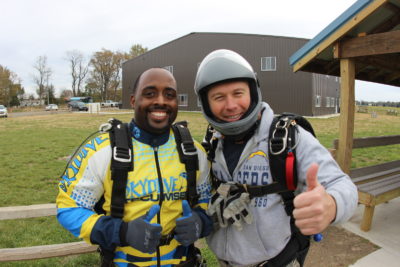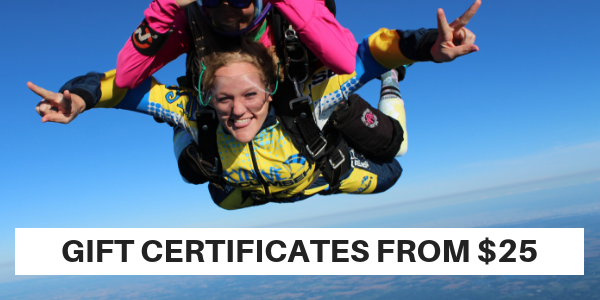- Michigan's Premier Skydiving Center
- Call Now: (517) 423-7720
Skydiving Equipment List
Wednesday, November 30, 2022
- Skydive Tecumseh
- 11/30/22
- 0
- Blog
Interested in skydiving on a regular basis? In addition to proper training, you’ll need to begin assembling all the requisite skydiving equipment. Like any niche sport, it’s not necessarily easy to know exactly what you need. To help demystify the equipment conundrum, we’ve created a skydiving equipment list that’s perfect for beginner skydivers.
Parachutes
This may come as no surprise, but one of the most essential pieces of equipment for skydiving is the parachute! But, did you know you’ll need not one but two parachutes in your skydiving equipment kit? That’s right. All parachute rigs for skydiving include both a main and a reserve parachute.
Main Parachute
 The main parachute in skydiving comes in a variety of styles and sizes. The type and size that an individual will select will depend upon the experience of the parachutist and the discipline of skydiving they are interested in.
The main parachute in skydiving comes in a variety of styles and sizes. The type and size that an individual will select will depend upon the experience of the parachutist and the discipline of skydiving they are interested in.
Did you know?
The main parachute used for tandem skydiving has a surface area between 340 and 360 square feet, and the parachute used by a student skydiver will usually be between 220 and 260 square feet. In stark contrast, the main parachute utilized by a professional skydiving canopy pilot is often less than 100 square feet!
Reserve Parachute
The reserve parachute is an equally important piece of skydiving equipment. Although it is unlikely that there will be an issue with the main parachute, in the event that there is a malfunction, the reserve parachute serves as a backup. While the main parachute’s design may utilize a design to produce speed and improved maneuverability, the reserve parachute is built to be reliable and docile. Generally speaking, it’s recommended that the reserve parachute be larger than the main parachute.
Parachute Rig
Also known as a container, the parachute rig is the backpack-looking piece of skydiving equipment that holds the main and reserve parachutes. Often skydivers will personalize their parachute rig with custom colors and embroidery. While having a skydiving rig with your favorite colors is great, above all else, skydivers purchase a custom rig in order to have it measured to fit them comfortably and securely.
While you can rent a skydiving rig (including parachutes) here at Skydive Tecumseh, it is subject to availability. It’s always good practice to call ahead to make sure a parachute rig is available.
This is also why we encourage newly-licensed skydivers to begin piecing together a used main, reserve, and skydiving rig as soon as is financially feasible.
AAD
The Automatic Activation Device (AAD) is another invaluable piece of parachute equipment. Essentially, the AAD is an uber-precise computer that is installed into the parachute rig and will deploy the reserve parachute in the event a skydiver is unable to do so.
More specifically, the AAD is able to calculate a jumper’s altitude and rate of descent by measuring changes in barometric pressure. Each AAD is programmed to deploy the reserve parachute when certain conditions (altitude and speed) are met. These incredible engineering marvels have saved countless lives and are a piece on our skydiving equipment list we simply cannot do without.
Visual Altimeter
In skydiving, it is imperative to maintain altitude awareness. This is why another key piece of skydiving equipment is the altimeter. Altimeters measure barometric pressure to determine altitude.
Altimeters come in both analog and digital models. Analog models look very similar to a watch face, except they only have a single hand. The single hand “ticks” around the face to indicate altitude – moving clockwise as altitude increases and moving counterclockwise as altitude decreases. A digital altimeter also reads altitude, but it displays it to the wearer in a digital format.
Audible Altimeter
In addition to a visual altimeter, many skydivers use an audible altimeter. An audible altimeter utilizes specific sounds to indicate preset altitudes. These tonal reminders are useful for jumpers participating in types of skydiving where they may not be able to see their visual altimeter at all times.
Helmet
 Next up on our skydiving equipment list is the helmet. Skydiving-specific helmets come in a variety of styles, sizes, and customizable designs. Like most helmets, the primary purpose of a skydiving helmet is to protect the wearer’s head. The majority of skydiving helmets are also constructed with an impact-rated hard-plastic shell.
Next up on our skydiving equipment list is the helmet. Skydiving-specific helmets come in a variety of styles, sizes, and customizable designs. Like most helmets, the primary purpose of a skydiving helmet is to protect the wearer’s head. The majority of skydiving helmets are also constructed with an impact-rated hard-plastic shell.
Skydiving helmets also come in open-face and full-face varieties. Full-face helmets have a sturdy plastic visor/face shield that covers the face. Open-face helmets lack this facial covering. Please note, if you choose an open-face helmet, you will also need a trusty pair of goggles.
Jumpsuit
Easily overlooked, the jumpsuit is a piece of skydiving equipment with considerable importance. It is possible to skydive without a jumpsuit. However, jumpsuits are useful when it comes to protecting yourself from the elements, creating uniform drag for improved performance, and – in the case of a skydiving discipline like wingsuiting – are completely necessary!
Like other pieces of skydiving equipment, jumpsuits can be custom purchased or can be found second-hand. Many jumpers begin with a used skydiving jumpsuit and wait until they decide on the skydiving discipline they will primarily pursue to purchase a perfectly-fitted custom jumpsuit.
Whether you’re a tandem or student skydiver, at Skydive Tecumseh, we’ve got your gear needs covered. New to skydiving and looking for used skydiving equipment? We can help you pick the right skydiving equipment for you – get in touch!
Copyright © 2025, Skydive Tecumseh, All Rights Reserved.
DropZone Web Design & Marketing by Beyond Marketing, LLC
